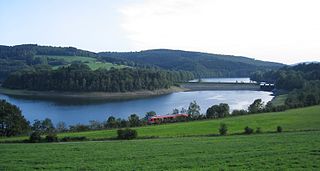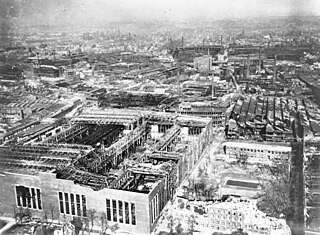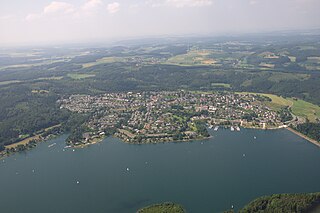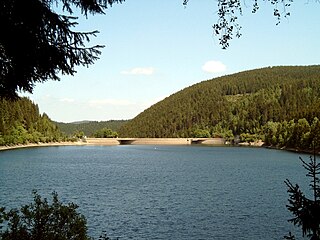
The Ruhr is a river in western Germany, a right tributary (east-side) of the Rhine.
Soest is a Kreis (district) in the middle of North Rhine-Westphalia, Germany. Neighbouring districts are Warendorf, Gütersloh, Paderborn, Hochsauerland, Märkischer Kreis, Unna and the independent town of Hamm.

Arnsberg is a town in the Hochsauerland county, in the German state of North Rhine-Westphalia. It is the location of the Regierungsbezirk Arnsberg administration and one of the three local administration offices of the Hochsauerlandkreis district.

The Sauerland is a rural, hilly area spreading across most of the south-eastern part of North Rhine-Westphalia, in parts heavily forested and, apart from the major valleys, sparsely inhabited.

Operation Chastise, commonly known as the Dambusters Raid, was an attack on German dams carried out on the night of 16/17 May 1943 by 617 Squadron RAF Bomber Command, later called the Dam Busters, using special "bouncing bombs" developed by Barnes Wallis. The Möhne and Edersee dams were breached, causing catastrophic flooding of the Ruhr valley and of villages in the Eder valley; the Sorpe Dam sustained only minor damage. Two hydroelectric power stations were destroyed and several more damaged. Factories and mines were also damaged and destroyed. An estimated 1,600 civilians – about 600 Germans and 1,000 enslaved labourers, mainly Soviet – were killed by the flooding. Despite rapid repairs by the Germans, production did not return to normal until September. The RAF lost 56 aircrew, with 53 dead and 3 captured, amid losses of 8 aircraft.

The Edersee Dam is a hydroelectric dam spanning the Eder river in northern Hesse, Germany. Constructed between 1908 and 1914, it lies near the small town of Waldeck at the northern edge of the Kellerwald. Breached by Allied bombs during World War II, it was rebuilt during the war, and today generates hydroelectric power and regulates water levels for shipping on the Weser river.

The Möhne Reservoir, or Moehne Reservoir, is an artificial lake in North Rhine-Westphalia, some 45 km east of Dortmund, Germany. The lake is formed by the damming of two rivers, Möhne and Heve, and with its four basins stores as much as 135 million cubic metres of water.

Sundern is a town in the Hochsauerland district, in North Rhine-Westphalia, Germany. The name Sundern is common in Westphalia, as it means "ground given away for private usage" in the Westphalian dialect.

Blue Mesa Reservoir is an artificial reservoir located on the upper reaches of the Gunnison River in Gunnison County, Colorado. The largest lake located entirely within the state, Blue Mesa Reservoir was created by the construction of Blue Mesa Dam, a 390 feet (120 m) tall earthen fill dam constructed on the Gunnison by the U.S. Bureau of Reclamation in 1966 for the generation of hydroelectric power. Managed as part of the Curecanti National Recreation Area, a unit of the National Park Service, Blue Mesa Reservoir is the largest lake trout and Kokanee salmon fishery in Colorado.

The Biggesee or Bigge Reservoir is a reservoir in Germany. It lies in the southern part of the Sauerland between Olpe and Attendorn.

The Battle of the Ruhr was a strategic bombing campaign against the Ruhr Area in Nazi Germany carried out by RAF Bomber Command during the Second World War. The Ruhr was the main centre of German heavy industry with coke plants, steelworks, armaments factories and ten synthetic oil plants. The British attacked 26 targets identified in the Combined Bomber Offensive. Targets included the Krupp armament works (Essen), the Nordstern synthetic oil plant at Gelsenkirchen and the Rheinmetal–Borsig plant in Düsseldorf, which was evacuated during the battle. The battle included cities such as Cologne not in the Ruhr proper but which were in the larger Rhine-Ruhr region and considered part of the Ruhr industrial complex. Some targets were not sites of heavy industry but part of the production and movement of materiel.

The hamlet of Langscheid is a part of the town of Sundern in the Sauerland in the district Hochsauerlandkreis in the federal state of North Rhine-Westphalia, Germany.

The Lenne Mountains, or Lenne Uplands (Lennebergland), is a range of hills up to 656 m above sea level (NN) high in the German state of North Rhine-Westphalia. It is part of the Süder Uplands within the Rhine Massif.

The Oker Dam is a dam in the Harz mountains in Lower Saxony, Germany. It is fed by the River Oker.

The Haar or Haarstrang is a ridge of hills on the southern edge of the Westphalian Basin in the German state of North Rhine-Westphalia. From a natural region perspective it is the southern, submontane part of the Hellweg Börde, which stands opposite the northern area of the Süder Uplands, north of the Möhne and Ruhr rivers.
Sorpe is a river of Hochsauerlandkreis, North Rhine-Westphalia, western Germany. It is a left (western) tributary of the Röhr, which is a tributary of the Ruhr, a tributary of the Rhine.

The Plackweghöhe, whose main summit has hitherto had no official name, is the highest point in the borough of Warstein, the hill ridge of the Plackwald, the North Sauerland Uplands, and the Arnsberg Forest Nature Park in the German state of North Rhine-Westphalia. It is 581.5 m above sea level (NHN) and lies within the counties of Soest and Hochsauerlandkreis. The Lörmecke Tower observation tower at the top is a popular destination.

The Vorotan Cascade, or the ContourGlobal Hydro Cascade, is a cascade on the Vorotan River in Syunik Province, Armenia. It was built to produce hydroelectric power and provide irrigation water. The Vorotan Cascade consists of three hydroelectric power plants and five reservoirs with a combined installed capacity of 404.2 MW. It is one of the main power generation complexes in Armenia.

Hachen is an Ortschaft (subdivision) of the town of Sundern in the Hochsauerland district of North Rhine-Westphalia, Germany. It is the second largest Ortschaft of Sundern.

































